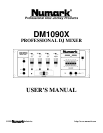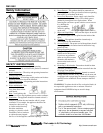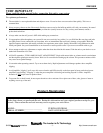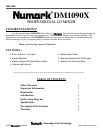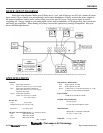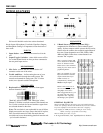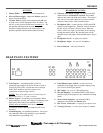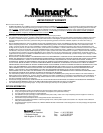
DM1090X
- The Leader in DJ Technology
©1999 Industries - 6 - http://www.numark.com
MIXER FEATURES
1
2
3
4
5
6
7
8
10
9
1311 12
14
We have divided this section into various functional
blocks: Inputs, Microphone, Crossfader, Equalizer, Outputs,
and Headphone Cueing. It is important to learn how each of
these work.
INPUTS
1. Input faders - control individual source levels in the
mix.
2. Input Toggle Switches - select which source will be
live to that channel based on what you have connected to
the rear panel input section.
MICROPHONE
3. Mic Gain– controls the mic volume for the 1/4”
connector on the rear of the mixer.
4. Treble and Bass – for fine-tuning the tone of your
voice on both mics through the sound system. The
controls are detented for setting tone "flat". For best
results, use a dynamic cardioid microphone.
CROSSFADER
5. Replaceable Crossfader - achieves clean segues
between channels 2 and 3.
"Hard left" selects Channel 2 and "Hard right" selects
Channel 3. With the crossfader centered, both channels are
live. Use the crossfader for fast and seamless segues from
one selected channel to the other.
Note: The crossfader is user replaceable in case of failure.
Simply unscrew the two large screws that hold it in place,
lift it out and disconnect its cable. Re-attach the new
crossfader and screw the mounting plate back onto the unit
- you’re back in business!
EQUALIZER
6. 5-Band Stereo Graphic Equalizer (EQ) -
compensates for differences in source material sound
quality. In ultra-compact mobile systems this EQ can be
used to tailor the sound to the acoustical requirements of
the room. Center frequencies are 63Hz, 250Hz, 1kHz,
4kHz and 16kHz. Faders have a center detent for an
accurate "flat” response.
This is a typical "house" EQ
curve. Notice how the knobs
above "0" balance out the
knobs below. Start with this
setting if you've never used a
graphic EQ before.
This is an example of a poor
EQ curve because it cuts the
output volume down by 6-
12dB. You have to
compensate by running the
Master output higher.
Below is the
worst
sort of
curve to use because you are
using EQ to add volume.
With exaggerated boost, you
can easily run your power
amplifiers into “clipping”
and damage your speakers.
GENERAL EQ HINTS
• Boost the 63Hz band for deep bass tones and solid kick drum
sound. Use sparingly because this dramatically increases demand
on power amplifiers and could drive them into “clipping” .
• Cut slightly at 250Hz and more at 1kHz for extra clarity.
Note: Cutting is preferable to boosting.
• Boost 16kHz for a little "sizzle".
• As a general rule, less equalization is better!



